December 30, 2007
Last time we had an image that looked blank and yet Pixcavator was able to detect objects that spelled “Hello!”. The reason was that humans can only recognize about 30 levels of gray while standard image formats have 256. Since the text was in virtually white (254) on white (255) background, it was invisible. This was supposed to illustrate the ability of computer vision to succeed where humans fail.
This last example was based on the failure to see small variations of luminosity. Now we have an almost identical example except it is based on the fact that humans can’t detect subtle variation of color (under fixed luminosity). The “blank” cyan rectangle below contains my initials “PS” which is found and displayed by Pixcavator on the right. The text written in color (0,254,255) – in the RGB model - that is only slightly different from the background (0,255,254). It is invisible to us but not to the computer. Once again my point is that image enhancement tools have nothing to do with computer vision.
 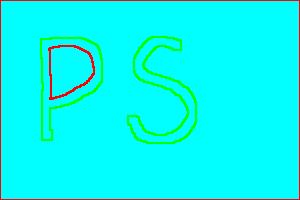
To verify that the image on the left contains the text you do need Photoshop again. This time Auto Contrast won’t help, but Smart Fix does work.
There will be another post on this topic.
December 23, 2007
Yesterday TechCrunch announced the finalists of Crunchies - its awards for best start-up companies/product. Twenty categories - all boring! Except for one at the top - Best technology innovation / achievement. The interesting part is that 3 out of 5 finalists have computer vision related products! This seems fair to me but, sadly, there is nothing to celebrate here. Certainly not from the point of view of technology. These are the companies:
Like.com – “likeness” image search for shopping. Searches sometimes make sense but also seem cooked up. Even then the engine is easy to trick: a search for a watch with a secondary dial returned many watches without. Bottom line, nothing new after a whole year.
Earthmine – reconstructing cities from street views, “first geospatially accurate and complete street-level 3D data”. Well, conversion of 2D to 3D isn’t going to work. If they collect images continuously by driving through the streets and then patching the images together (that’s unclear), they get a 3rd dimension. Bottom line, even their demo shows only static (panoramic) shots not a true 3D reconstruction.
Viewdle – face recognition in videos. Makes a good demo but there is no way to test it. Can such technology ever be reliable? Once again it’s the 2D-to-3D issue. Bottom line, how is it better than Polar Rose?
None gets my vote.
December 19, 2007
I’ve been thinking about this for a couple of days…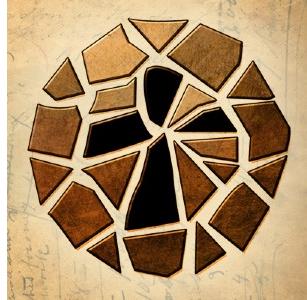
Mosaic making is both an art and craft. Even after the art part is over one still faces the challenge of manufacturing and keeping track of all those pieces. There may be hundreds in a stained glass window or thousands in a pool. Of course, a spreadsheet would help to make the list of all pieces. But you’d have to create this list from scratch by manually finding and recording the location of each piece. Once it’s done, you still need to find a way to manufacture your pieces. Unless they all have standard shapes, you face a lot of tedious manual work just to create templates for them.
So, you need software to make this process automatic.
Here is how Pixcavator could help. Suppose the designer has a sketch of a picture. Then he may draw the pieces of the mosaic on that sketch. In fact, Pixcavator has a ‘mosaic’ command among image processing tools, so you can skip this step. Next Pixcavator image analysis is run. The output is the following:
- a spreadsheet with locations and sizes of all pieces, and
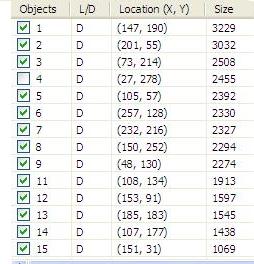
- a set of images, one for each piece.
Next let’s see where Pixcavator falls short from the ideal, for now. First, it would be nice to have color and shape (there will be ‘roundness’ column in Pixcavator 2.4) of each piece in the spreadsheet. Second, to produce the images of the pieces I had to use “Isolate objects” for each. That takes 4 clicks plus typing the name of the image – for each piece. That’s impractical. Clearly, once the image is analyzed one click should create all images at once. Thirdly, these images are currently of the same size as the original. That’s also impractical.
I believe that these problems are easy to overcome with Pixcavator SDK, so I’ll give it some thought. Updates will appear in the wiki.
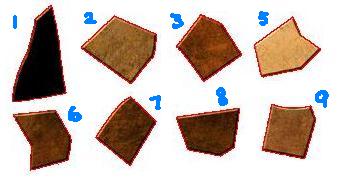
December 16, 2007
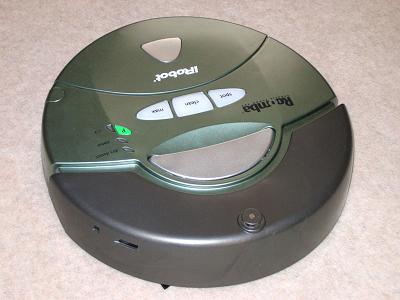
I am being sarcastic here, of course. I own a Roomba and I am aware that its navigation is based on bumping into walls and furniture. So, it doesn’t use computer vision in the usual sense of the word. The point here is that computer vision (and AI in general) is a field which is about to change the world, always. But so far it hasn’t. Compare that to Roomba. It’s quite dumb but it does its job and now you can have a robot in our house for the first time ever! So I’d say that Roomba has changed the world, a bit.
A candidate for a commercial success of the “real” computer vision may be face detection. It is now installed on many cameras like Canon. However, for the user it’s just a minor feature. Unlike Roomba. My guess is that a success of this magnitude is more likely to come from a vision system that is just a notch more complex than Roomba’s.
BTW, the Roomba does have vision however rudimentary. It does not detect vertical changes, so it is fair to say that its vision is 1-dimensional. Taking time into account it’s 2-dimensional. Another 1D vision system is radar.
December 14, 2007
The extended abstract of the presentation is here - PDF. It will be given at Workshop on Bio-Image Informatics: Biological Imaging, Computer Vision and Data Mining, 2008, Center for Bio-Image Informatics, UCSB, Santa Barbara, CA, USA, January 17-18, 2008. We will be testing cellAnalyst now. More updates to come.
BTW, counting objects is by its nature a topological issue. So, from the topological point of view there shouldn’t the word ‘topological’ in the title!
Update: cellAnalyst can be downloaded at cellAnalyst.net.
December 9, 2007
For a while I’ve been planning to resume reviews of image search applications but couldn’t decide which one to start with. The decision was made for me – coverage of Polar Rose (last reviewed in March) appeared. Was it in TechCrunch? No, it appeared in Time Magazine!
They should be embarrassed.
Let’s start with this quote at the top of the page in large letters: “these Tech Pioneers show that the best technology is often just a new way of thinking about an old problem” (bold face theirs). So you don’t need expertise or hard work, all you need is to be original. A feel-good idea for little kids…
Now about the article itself. It occupies just a half-page but there is also a whole page picture on the front page of the series “Tech Pioneers”. As far as image search is concerned the article repeats the old promises of the founder: “click on a photo to search for other photos”, “turns photographs into 3-D images”. A new promise is this: plug-in for FF is given away and the one for IE coming soon. OK fine, let’s go to the site, download and test it. Imagine my surprise when I discovered that there is only beta testing going on! The testing is closed and there is no way to try it. How come it’s not available? “It’s a very slow business…”, according to the founder.
My guess is that the reporter didn’t try it either. Apparently, the whole thing came to Time from the World Economic Forum. Here Polar Rose promises to launch face matching “later this year”. We’ll see…
December 5, 2007
A few recent developments:
The number of downloads of Pixcavator 2.3 has reached 10,000.
Idee has re-launched its visual image search application. There is no image uploading and as a result no way to test it. But even sSearching within its own collection of images indicates that shapes aren’t given serious consideration. More on image search here. More updates to come.
Last Sunday Ash Pahwa and I attended the exhibit of the annual meeting of the American Society for Cell Biology in Washington DC. We talked with some companies that make image analysis and related software. Nothing spectacular. Most interesting was the conversation with Ilya Goldberg, the representative of OME (Open Microscopy Environment).
A quick analysis revealed that the time complexity of the image analysis algorithm that runs Pixcavator is O(n2), where n is the number of pixels in the image.
|
|
|




















